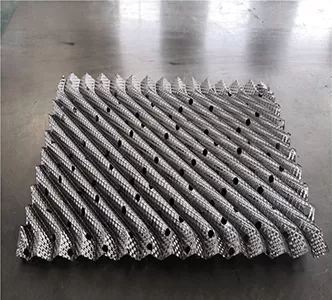Is Structured Packing Better Than Pall Rings?
The question of whether structured packing is "better" than Pall rings depends on the specific requirements of the industrial process, as each type offers distinct advantages tailored to different scenarios. Neither is universally superior, but their performance differs in key areas such as efficiency, pressure drop, and application suitability.

Structured packing, characterized by its regular, ordered arrangement of corrugated sheets or meshes, excels in high-efficiency separation processes. Its uniform channel structure ensures superior gas-liquid distribution, minimizing issues like channeling or bypassing that can occur in randomly stacked packing. This design leads to higher mass transfer efficiency, making it ideal for precision separation tasks such as vacuum distillation, fine chemical purification, or processing of heat-sensitive materials. Additionally, structured packing typically exhibits lower pressure drop compared to Pall rings, which reduces energy consumption—an important factor in large-scale or continuous operations.
Pall rings, a type of random packing, have their own strengths. As individual annular units with windowed walls and overlapping blades, they are simpler to install and replace, especially in small or irregularly shaped towers. Their random stacking allows for greater flexibility in handling varying flow rates and fouling conditions, as the loose arrangement is less prone to clogging by solids or heavy deposits. Pall rings are also often more cost-effective in low to medium-efficiency applications, such as general absorption or stripping processes, where extreme precision is not required.
In terms of scalability, structured packing is more suitable for large-diameter towers, where its ordered structure maintains consistent performance across the entire cross-section. Pall rings, while effective in smaller towers, may struggle with uniform distribution in larger vessels, leading to reduced efficiency. However, Pall rings offer better tolerance to mechanical stress and irregular flow, making them a reliable choice in processes with fluctuating operating conditions.
Material considerations also play a role. Both structured packing and Pall rings are available in metals, plastics, and ceramics, but structured packing’s design often maximizes the benefits of high-performance materials (e.g., corrosion-resistant alloys) for extreme conditions. Pall rings, meanwhile, are widely used in cost-sensitive applications with plastic or standard metal materials.
In summary, structured packing is "better" for high-efficiency, low-pressure-drop, and precision separation needs, while Pall rings excel in flexibility, ease of maintenance, and cost-effectiveness for simpler processes. The choice depends on factors like separation efficiency requirements, energy constraints, tower size, and operating conditions—with each type optimizing performance for its intended use case.

